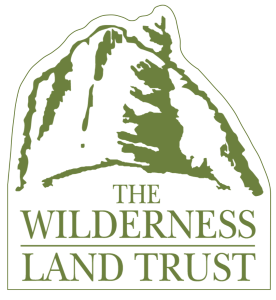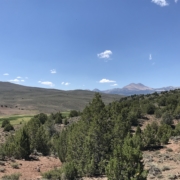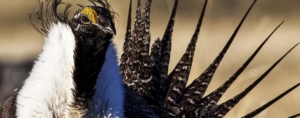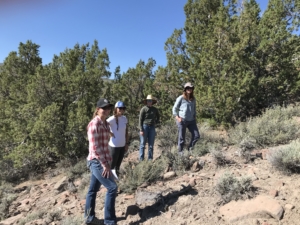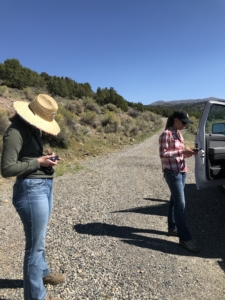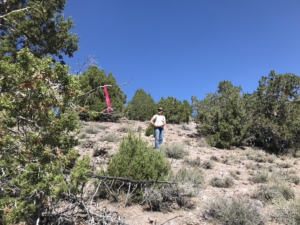Boots on the Ground: California
August 26, 2022-
Boots on the Ground: A Site Visit Series
The Trust is fortunate to share frequent stories of success with you. One critical component of our work leading up to the success is visiting each property in person. As part of our own due diligence during the acquisition and transfer phases, we join with our partners to meet landowners, inspect property conditions, validate property boundaries, create a plan for any stewardship needs, execute restoration plans and experience the wilderness character for ourselves. These trips often require logistical planning and backcountry travel, but are one of the most fulfilling duties of our work. We invite you into the wilderness with us on our last site visit.
Date: August 19, 2022
Location: Mormon Meadows Property, Bodie Hills Wilderness Study Area, CA
Staff: Aimee Rutledge
Theme: Lekking Juniper Sage Territory
The field day started at the 960-acre Mormon Meadows property along Clearwater Creek in Bodie Hills, CA. The Wilderness Land Trust acquired this property in 2019. Multiple agency partners, including the US Department of Agriculture, Natural Resources Conservation Service and US Fish and Wildlife Service, are providing funds to the Trust to restore this property for sage grouse before we transfer the property to the US Bureau of Land Management for permanent protection.
All around the meadow, juniper forests have encroached on former sagebrush habitat. Generally, in the western United States, junipers became 600% more dense in the last 150 years. Sage grouse, a bird that evolved in a large and treeless landscape, suffer when trees take over. Birds avoid mating or nesting if there are more than a couple trees on the landscape, likely because conifer woodlands are riskier habitats for grouse with more predators. Other sagebrush-reliant wildlife like mule deer and songbirds are also negatively impacted when conifers crowd out the perennial plants they need for food and cover.
A study from the Warner Mountains, an area with similar sagebrush habitat to the Bodie Hills, found that 29% of marked hens moved back to nest in restored habitat just three years after conifers were cut. Additional research in the Warners also revealed the abundance of sagebrush-loving songbirds, also species adapted to large treeless expansions, doubled following restoration through juniper removal. For more information see this link.
But, as always, balance is extremely important. Heritage juniper trees have many traditional uses for Native Americans (bark for primitive camp fire-starts and roof thatch, smoking for deerskin tanning, wood for kitchen utensils and bows, greens and/or dried berries for teas for treating fever, pain, and other health uses, digging sticks as well as potential food or flour in times of need), and provide habitat for pinyon jays. So, our team’s job was to mark older, heritage junipers for retention before starting the restoration project. We first hiked into the trees to discuss how to mark large, heritage juniper trees for retention, including trunk sizes, bark texture, and crown appearance.
We then prepared GPS equipment with the boundaries of the restoration area surrounding the meadow and creek, including former documented leks or breeding grounds for the sage grouse. And, we grabbed plenty of water and donned hats and sunscreen for our work in the high altitude Eastern Sierra sun. The Bodie Hills are around 7,000 feet in elevation and stretch from the Eastern side of the Sierra to the California-Nevada border just north of Mono Lake. They contain three wilderness study areas and host migrating deer and pronghorn antelope, along with sage grouse and many other species.
We split up into teams to survey different restoration sections and took off up hillsides around the meadow. We carefully looked for the types of trees we had discussed and marked each tree meeting our criteria multiple places with bright pink forester’s tape, wrapping each marker twice around a branch before we tied it to make sure it stayed on.
The end of our day brought us to the top of a ridge with a vista of tall Eastern Sierra peaks. We tried to “think like a grouse” and picture the overall landscape post-restoration as we looked down over the hillside we had marked, visualizing the marked trees spread in restored sagebrush habitat.
At the end of the day, we were parched. The importance of water sources like Clearwater Creek for breeding, migrating and feeding in this dry landscape became abundantly clear especially in the face of climate change and increased drought.
We wish you great adventures in wild places as summer winds down and we thank you for your continued support of our work.
Keeping the Promise of Wilderness,
Aimee
